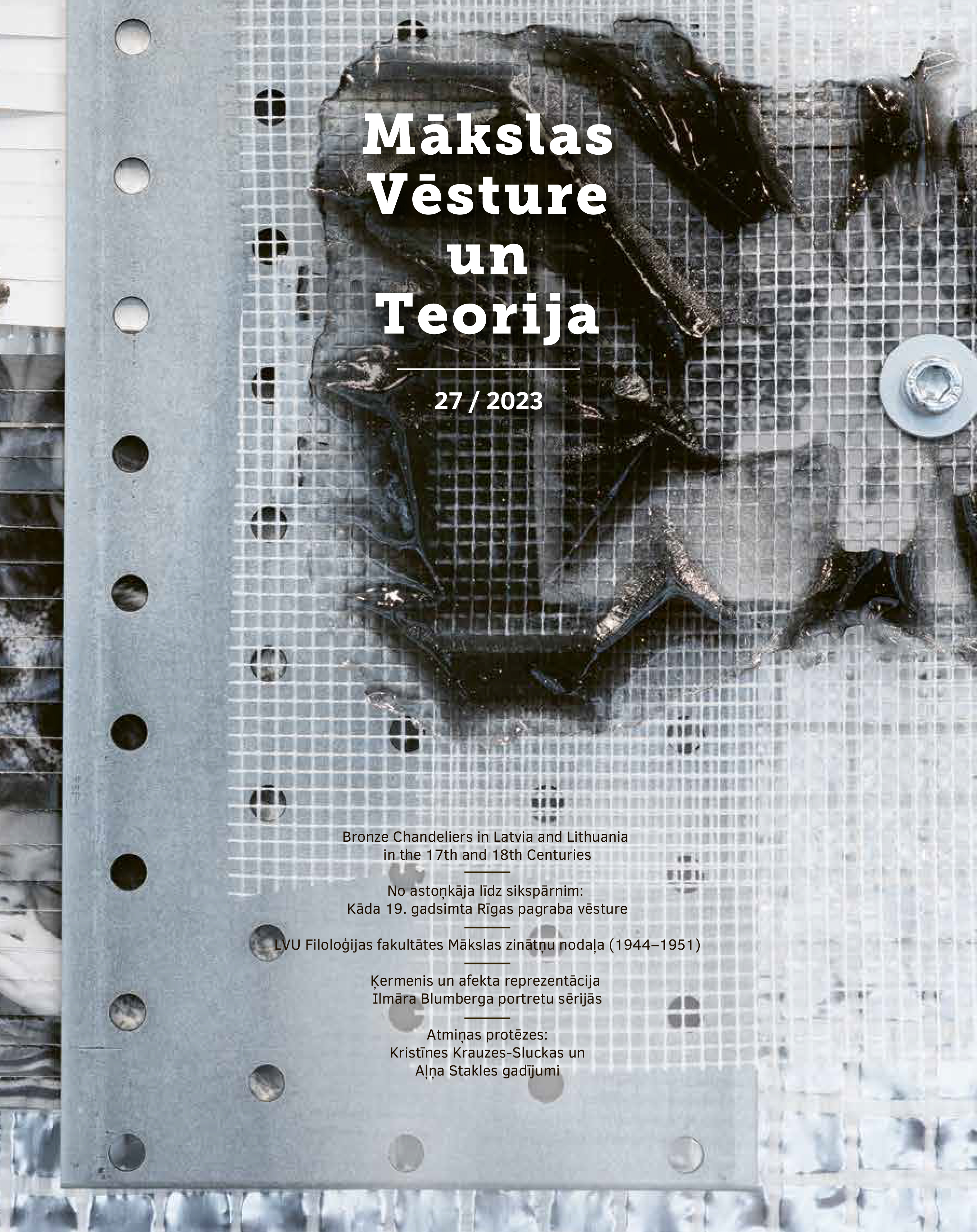No astoņkāja līdz sikspārnim: Kāda 19. gadsimta Rīgas pagraba vēsture
From Octopus to Bat: The Enigmatic Underwater Kingdom of 19th Century Riga
Author(s): Lauma LancenieceSubject(s): Cultural history, Museology & Heritage Studies, Photography, Visual Arts, 19th Century, History of Art
Published by: Mākslas vēstures pētījumu atbalsta fonds
Keywords: Photography; Krakenbank society; Riga Baltic-German community; cultural history; Riga History and Navigation Museum;
Summary/Abstract: This article explores a mysterious collection of photographs discovered in the archives of the Riga History and Navigation Museum, offering a glimpse into the captivating underwater kingdom of 19th century Riga. The photographs, dating back to 1894, showcase an elaborately decorated fictional realm within the premises of the Krakenbank literary and music society. The article explores the history of the society, the inspiration behind the underwater theme, and the artistic contributions of its members. It also discusses the subsequent transformations of the location and its significance in Riga’s cultural history.The article begins by introducing the hidden collection of photographs found in the Riga History and Navigation Museum archives. The photographs, accompanied by poetic verses, depict a fantastical underwater realm adorned with wall paintings, sea creatures and mythical figures. Each room is named with a romantic title, providing a captivating glimpse into a bygone era.The photographs are made in the collodion POP technique, known for its warm brown tones and glossy surface. This technique was popular in the late 19th century but was eventually surpassed by silver gelatin. The author of the album is Emanuel von Eggert (?–1916), who opened his photo studio together with Carl Maria Hebensperger (1858–1939) in 1885. It was situated in Riga at 6 Alexander Street (now 40 Brīvības). Eggert’s photo studio was one of the most popular at the end of the 19th century in Riga. It offered individual and group portraits, as well as capturing official events such as the Latvian Ethnographic Exhibition in 1896. The album’s red calico cover, crafted by G. Röttger’s leather goods factory, follows the tradition of souvenir photography albums depicting notable city landmarks and landscapes.The Krakenbank society was established in 1869 as a charitable organization for the Baltic-German community in Riga. The society provided financial support and organized cultural events. The photographs captured the interiors of the society’s meeting place, located at 8 Merķeļa Street in Riga, which still stands today. The album was created to commemorate the society’s 25th anniversary in 1894.The article highlights the significance of this discovery in providing an insight into the cultural life of 19th century Riga. It showcases the creativity and imagination of the Krakenbank society’s members and sheds light on the architectural contributions of architect Karl David Neuburger (1844–1897) and Riga City Theatre stage designer Friedrich Hellwig (1832–1898), who both designed the society’s meeting place. Furthermore, the article delves into the inspiration behind the underwater kingdom theme. It discusses ancient Scandinavian mythological texts, such as the Edda books, and their influence on the society’s adaptation of the underwater realm concept. Among the other members the author highlights the contributions of Julius Meyer (1846–1922), a significant figure in the literary life of 19th-century Riga and a prominent member of the Krakenbank society. Another interesting source that was examined is the experience of German writer Joachim Ringelnatz (1883–1934) during his visit to the Krakenbank society. His diary entry provides insights into the society’s humorous approach to life and the underwater-themed premises adorned with sea monster paintings.As World War I unfolded, the society’s activities declined. The interior remained unchanged until 1925 when the Latvian artists’ association Zaļā vārna transformed the space into a vibrant hub of artistic activities, featuring interactive art performances influenced by Futurism and Dadaism.Additionally, the article explores the transformation of the Merķeļa Street location over the years. It highlights the subsequent use of the location as various dining establishments. For almost the entire second half of the 20th century, the basement of 8 Merķela Street became legendary as the location of the restaurant Kaukāzs. It opened on 16 October 1948 and existed until 1993 – that is, 45 years. The restaurant specialized in Caucasian cuisine.Examination of the enigmatic underwater kingdom depicted in the 19th century photographs found in the Riga History and Navigation Museum explores the history and cultural significance of the Krakenbank society, the artistic contributions of its members, and the subsequent transformations of the location. The captivating photographs and their accompanying stories offer a fascinating glimpse into the rich cultural heritage of 19th century Riga.
Journal: Mākslas Vēsture un Teorija
- Issue Year: 2023
- Issue No: 27
- Page Range: 22-35
- Page Count: 14
- Language: Latvian
- Content File-PDF

